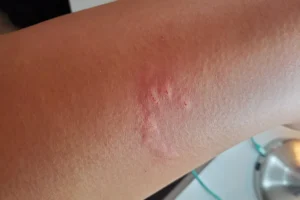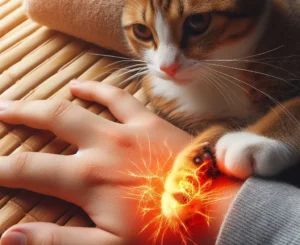Ouch! Stray cat scratches can be more than just a painful nuisance – they could be potentially hazardous.
We understand the frustration you might feel when a seemingly harmless encounter with a local feline leaves you with a nasty scratch.
Even worse, the uncertainty that follows can be alarming, questioning what potential risks may lie beneath the surface. Are you in danger of catching a disease? Should you go see a doctor? These valid concerns and more will be addressed in this guide.
Stay tuned as we answer these questions, offering expert advice and practical solutions to keep you safe and informed.

Should You Be Worried About a Stray Cat Scratch?
A stray cat scratch might seem like an innocent accident, but it’s essential to approach it with caution.
Cats, especially strays, can carry bacteria in their claws, which can cause an infection known as Cat Scratch Disease (CSD). While CSD often presents mild symptoms like swollen lymph nodes and fever, it’s still an issue that should not be overlooked.
However, let’s keep in mind that not all cat scratches lead to CSD or other diseases – it’s not a guaranteed outcome, but it’s always better to be prepared and informed.
Tetanus: Do I Need a Shot After a Cat Scratch?
The question of tetanus often pops up after an unexpected scratch.
Although tetanus is more commonly associated with puncture wounds rather than scratches, it’s still possible, albeit rare, to get it from a cat scratch, particularly if the wound is deep and was contaminated with soil.
The Tetanus bacteria typically reside in the soil, dust, and manure, not cat claws. However, if you haven’t had a tetanus shot in the last ten years (or five for a severe wound), it would be a good idea to update your vaccination, cat scratch or not.
As always, when in doubt, a quick call or visit to your healthcare provider is the best course of action.
Rabies and Cats: How Common Is It?
You may be wondering about the risk of rabies from a stray cat scratch. While it’s essential to address this concern, it’s also vital to understand that rabies in cats, especially in the U.S., is relatively rare.
Thanks to widespread pet vaccinations, rabies cases in domestic animals have decreased dramatically. However, stray cats aren’t typically vaccinated, which does elevate the risk slightly.
But remember, rabies is transmitted through the saliva of an infected animal, typically through a bite, not a scratch. The chances of getting rabies from a scratch are extremely low unless the cat had saliva on its claws.
In short, while it’s not impossible, the risk is very minimal. If the cat appeared sick or behaved erratically, it would be wise to consult with a healthcare provider promptly.

First Aid for Cat Scratches
Getting a scratch from a stray cat might be alarming, but don’t panic – taking immediate and appropriate action can reduce potential risks significantly. Here’s a step-by-step guide on what to do if you find yourself on the receiving end of a stray cat’s claws:
- Clean the wound. The first step is to clean the scratch thoroughly with warm water and mild soap. This can help wash away any bacteria that may be present.
- Apply an over-the-counter (OTC) antibiotic ointment. Once the wound is clean, apply an antibiotic ointment such as Neosporin to prevent infection.
- Cover the scratch. After applying the ointment, cover the scratch with a clean bandage or dressing.
- Monitor the wound. Keep a close eye on the scratch for signs of infection, such as redness, swelling, or pus. Any immediate swelling should normally subside quickly. If it remains after a few hours, particularly after a day, it could indicate an infection. The appearance of blisters or a rapid increase in pain are other signs to look out for.
- Seek medical attention if needed. If you notice any signs of infection or if the wound doesn’t seem to be healing, it’s time to consult with a healthcare provider.
Remember, your health is paramount. Even if the risk is low, it’s essential to take any cat scratch seriously, especially from a stray. Your own cat carries lower risks, and even a cat scratch scar may go away, but strays carry a higher risk of something going wrong.
Keeping these steps in mind and practicing prompt first aid can make a substantial difference in the outcome. Be prepared, be proactive, and stay safe with these tips on how to safely pet a stray cat.
When to Seek Medical Help? (and my story)
It’s no joke when a peaceful stroll turns into a scuffle with a feral feline.
It was during a laid-back summer break in college when I decided to take a detour through an old alley in my hometown. There was this stray cat, scruffy and mottled, lurking behind a rickety old crate. The alley was quiet, a little too quiet, and then out of nowhere, the cat sprang up and gave me a quick scratch on my arm. Being a carefree teenager, I just brushed it off, thinking it was nothing serious.
But, by nightfall, the scratch turned red and puffy, almost like a mini mountain range on my arm. It was warm to the touch and throbbing slightly, a clear sign that my body wasn’t too happy about the situation. That day taught me a valuable lesson: never underestimate a minor scratch, especially from a stray animal. Always pay attention to your body, because it often knows better.
Seek medical help if you see signs of infection, such as redness, swelling, or pus at the scratch site. You should also contact a healthcare provider if the cat that scratched you appeared sick or was acting strangely, as this could potentially indicate rabies.
Other red flags include a deep scratch or puncture wound, fever, tiredness, headache, or swollen lymph nodes. Don’t delay if you’re at high risk, for instance, if you have a weakened immune system or if the scratch is near your eyes or mouth.
At the end of the day, it’s your well-being on the line. Indoor cat scratches are one thing, but this is different. Don’t gamble with it; when in doubt, always opt for a medical consultation. Stay alert, stay informed, and take care.
FAQs
Can other animals carry diseases similar to cat scratch disease?
Absolutely. Cat Scratch Disease, caused by the bacterium Bartonella henselae, is not exclusive to cats. Dogs, and even cattle, can also harbor this bacterium and can potentially pass it on through bites or scratches.
What should be my immediate response to a cat scratch?
The first response should be to clean the wound with warm water and soap, then apply an over-the-counter antibiotic ointment, followed by covering the scratch with a clean bandage or dressing.
How can I discourage a stray cat from approaching?
If you encounter a stray cat in an outdoor environment like an alley, avoid direct eye contact as cats can interpret this as a threat. Do not approach or attempt to touch the cat. Slowly step back and maintain a non-threatening posture. If you do speak, do it in a low, calm voice.
Is it safe to feed stray cats?
While feeding stray cats is an act of kindness, it can encourage them to return regularly, potentially leading to scratches or bites. It can also result in increasing the stray cat population in the area, causing more harm than good (territory issues, spread of diseases, etc.). Opt for TNR programs.
Alex, a passionate animal lover, has experience in training and understanding animal behavior. As a proud pet parent to two dogs and three cats, he founded AnimalReport.net to share insights from animal experts and expand his knowledge of the animal kingdom.









